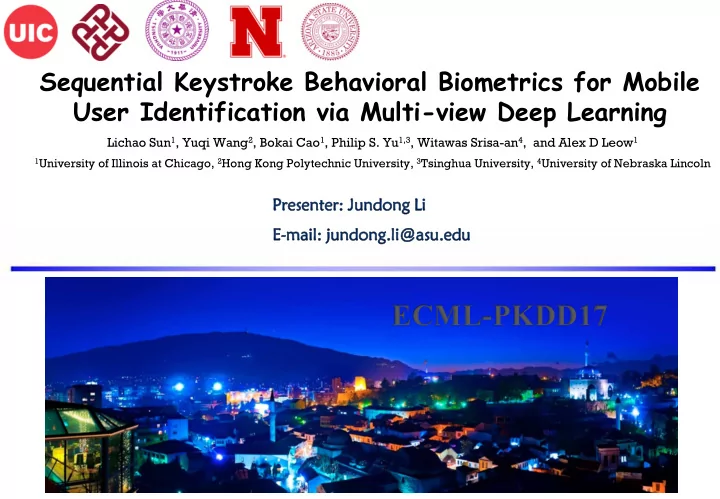

Sequential Keystroke Behavioral Biometrics for Mobile User Identification via Multi-view Deep Learning Lichao Sun 1 , Yuqi Wang 2 , Bokai Cao 1 , Philip S. Yu 1,3 , Witawas Srisa-an 4 , and Alex D Leow 1 1 University of Illinois at Chicago, 2 Hong Kong Polytechnic University, 3 Tsinghua University, 4 University of Nebraska Lincoln ECML-PKDD17
OUTLINE 1 Problem 2 Methodology 3 Experiments 4 Conclusions 2
Problem Statement Backgrounds Our task 3
Problem Statement Authorization Identification System System Owner or Not ? Sam/John/Bob is using Our task 4
Problem Statement Authorization vs Identification Stolen Phone Recommendation • • Using the Phone Auto Personal • • without Owner’s Setting Changing Permission 5
Problem Statement Traditional Identification Account Weakness: + • Not Convenient • Security Issues Passward 6
Problem Statement Major Challenges…… 2. Data Features 1. High Identification Design Performance 3. Data Privacy 7
Problem Statement Feature Design & Selection Authorization vs Identification Accelerometer Accelerometer Gyroscope Tap gesture Magnetometer Key press on virtual keyboard Raw touch event Tap gesture Scale gesture Scroll gesture Fling gestur Key press on virtual keyboard … 8
Problem Statement Solution I : Single-view Traditional Learning Multi-class Traditional Learning: Support Vector Machine Decision Tree Random Forest Logistic Regression 9
Problem Statement Solution II : Single-view Deep Learning 10
Problem Statement Solution III : Multi-view Deep Learning 11
OUTLINE 1 Problem 2 Methodology 3 Experiments 4 Conclusions 12
Multi-view Multi-class Deep Learning Step I : Auto-encoder for Each View Representation of Each View A GRU is formulated: Inputs of Each View 13
Multi-view Multi-class Deep Learning Step II : Concatenate Representations of Each View 14
Multi-view Multi-class Deep Learning Step III : Softmax & Output Softmax Function Multi-class Output: [0,0,0,1,0,…,0]: single one value Result: Index of 1 is the multi-class 15
OUTLINE 1 Problem 2 Methodology 3 Experiments 4 Conclusions 16
Experiments Datasets • 40 Volunteers • 26 of 40 Active Users (17 females and 9 males) • 8 Weeks • 11 – 63 years old • Minimum: 29 Maximum: 4702 Times Usage of the Phone 17
Experiments Pattern Analysis 18
Experiments Results 19
20
OUTLINE 1 Problem 2 Methodology 3 Experiments 4 Conclusions 21
Conclusions We have shown that DEEPSERVICE can be used effectively to identify multiple users. Even though we only use the accelerometer in this work, our results show that more views of dataset can improve the identification performance. – DeepService is the first system for mobile user identification – DeepService is the best model for multi-view multi-class dataset – DeepService takes about 0.657 ms per session which shows its feasibility of real-world usage 22
Thank you !
Recommend
More recommend